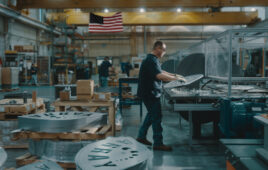Over the last several years, the shape and size of mounts used in residential solar projects have changed to a lower profile attachment that can be installed over the shingle instead of slid underneath like metal flashing sheets. The next obstacle in residential solar design was expanding these top-mounted attachments that could primarily be installed on rafters onto the decking surface of the roof. Ryan Estrada, technical program outreach manager, and Nico Martinez, senior product manager at Unirac, are here to discuss what’s new with solar mounting and, more specifically, the advancement of direct-to-deck attachments.
A written portion of this podcast is below but be sure to listen to the full episode on your preferred podcast service.
SPW: What are the latest trends in solar PV racking technology?

Nico Martinez, senior product manager, Unirac.
Nico Martinez: We’re starting to see rail-less make a little bit of a comeback here in the solar racking industry. We’ve also seen a big push for open channel rail systems, both of which we provide here at Unirac. But rail-less, we’re starting to see a lot of of our competitors starting to focus on those types of systems. There are some big pros there. It can help reduce the number of attachments, which as we all know, one of the ways that your crews get called back to a house is with roof leaks. So, if you can reduce the number of attachments that are penetrating that roof, that really helps. Then it also helps reduces labor time for crews.
Ryan Estrada: Another trend we’re seeing is polymeric or chemical flashings for roof attachments. What’s gained a lot of popularity now is the butyl mastic roof attachments, and these will go directly on top of the shingle. So, the benefit there is you don’t have to pry nails, you don’t have to risk damaging shingles in cold weather when it gets really rigid. You don’t have to pop up nails and create holes and then backfill them, and it’s been tested and tried and true in different industries, and now it’s making a comeback in solar power on top of your comp shingles.
How do racking manufacturers ensure due diligence in testing direct-to-deck connections?

Ryan Estrada, technical program outreach manager, Unirac.
RE: An interesting topic here because the typical test standards used in the industry are made for connection into the rafter. And so the test standards haven’t fully caught up to what the industry is doing with deck attachment. So your typical rafter-attached test standards are ASTM 7147, which is a specification for testing and establishing allowable loads of joist hangers. And then there’s 1761 which is the standard test for mechanical fasteners and wood-based materials. The gaps that we see in using these standards for direct deck is that it’s really limited.
NM: What we’ve discovered when we’re doing some side-by-side comparison testing with our competitors, especially on the direct-to-deck attachments, is that these loads that some of our competitors are claiming, No. 1, we’re having a hard time meeting, and No. 2, it’s in a very controlled laboratory setting. What we really tried to focus on in our testing — and this is why we’ve taken a very strict engineering approach, I know some people may think we might be a little overly conservative sometimes — but the reason that we do that is we don’t want our cause the issues on your roof, on your solar, because once that starts happening, it’s not just bad for Unirac, but it’s bad for the entire industry.
Why does Unirac go above and beyond the minimum building code requirements?
RE: We can all agree that we’re going to have more severe weather events in the future. And we’re seeing a high frequency of severe weather, and we expect that to continue. Roofs are designed to withstand uniform loading, so uniform snow loads or uniform wind loads. When you attach direct to deck, you’re turning that uniform load into point loads. Once you reach a certain threshold, you can actually start to weaken that roof. We really do our research and due diligence in identifying that and we’re not just making solar mounting systems, it’s an ecosystem that’s tied in with building and construction, we have to follow the building codes.
Not all direct-to-deck connections are bad, right? It’s just a matter of knowing what the limit is and what that threshold is.
This podcast is sponsored by Unirac




Good reporting on the as noted issue of roof integrity under increasing storm energies. Please clarify “direct to deck” attachments. It seems to be, in contrast to screws to rafters, that the panels’ support structure is just screwed to the roof sheathing with no concern about reaching the supporting rafters.
I seem to have noticed a trend to fewer attachments between roof & panel supports. That implies larger loads at each roof contact, which would seem to require connections to the rafters.